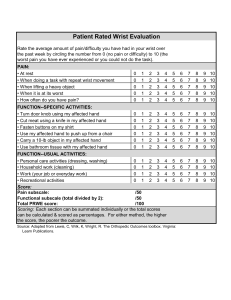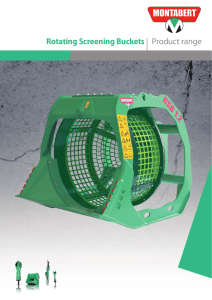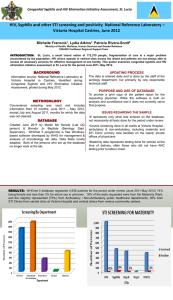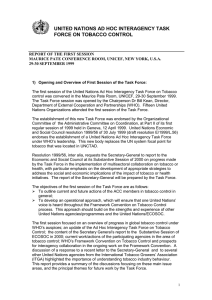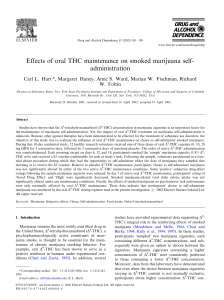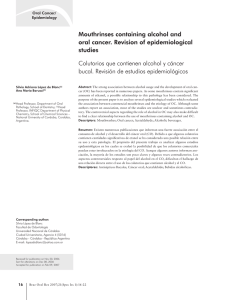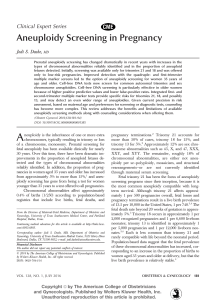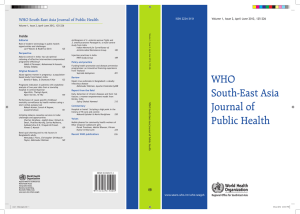Validity and Reliability of the Alcohol, Smoking, and
Anuncio
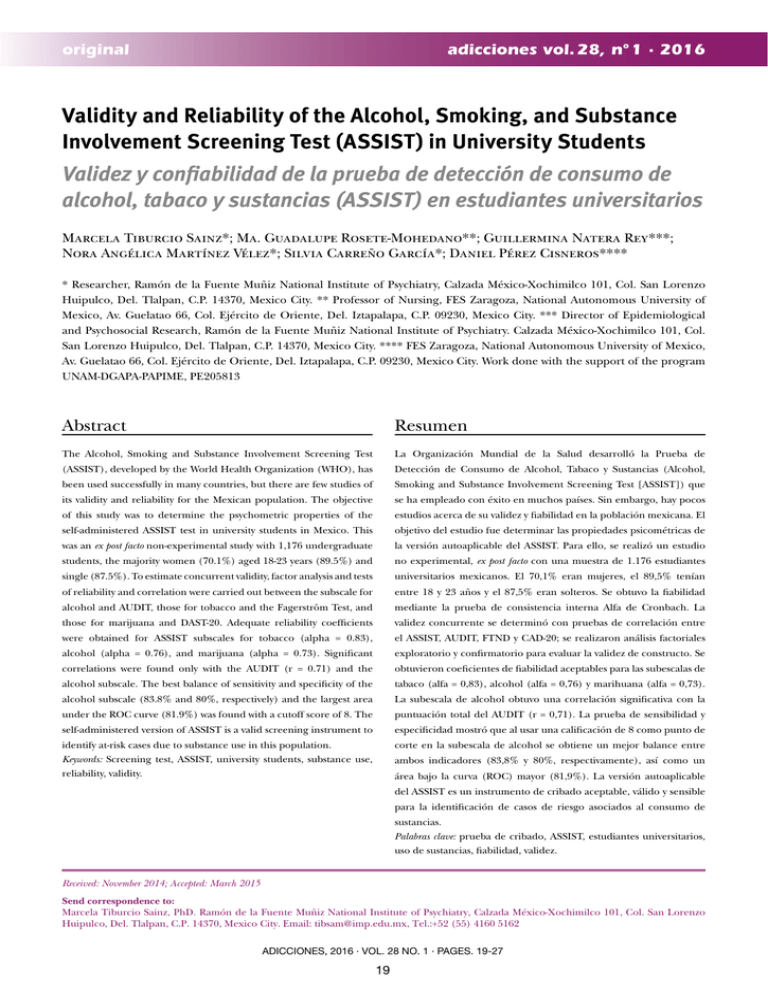
original original adicciones adicciones vol. vol. 28, 28, nº nº 1 1 ·· 2016 2016 Validity and Reliability of the Alcohol, Smoking, and Substance Involvement Screening Test (ASSIST) in University Students Validez y confiabilidad de la prueba de detección de consumo de alcohol, tabaco y sustancias (ASSIST) en estudiantes universitarios Marcela Tiburcio Sainz*; Ma. Guadalupe Rosete-Mohedano**; Guillermina Natera Rey***; Nora Angélica Martínez Vélez*; Silvia Carreño García*; Daniel Pérez Cisneros**** * Researcher, Ramón de la Fuente Muñiz National Institute of Psychiatry, Calzada México-Xochimilco 101, Col. San Lorenzo Huipulco, Del. Tlalpan, C.P. 14370, Mexico City. ** Professor of Nursing, FES Zaragoza, National Autonomous University of Mexico, Av. Guelatao 66, Col. Ejército de Oriente, Del. Iztapalapa, C.P. 09230, Mexico City. *** Director of Epidemiological and Psychosocial Research, Ramón de la Fuente Muñiz National Institute of Psychiatry. Calzada México-Xochimilco 101, Col. San Lorenzo Huipulco, Del. Tlalpan, C.P. 14370, Mexico City. **** FES Zaragoza, National Autonomous University of Mexico, Av. Guelatao 66, Col. Ejército de Oriente, Del. Iztapalapa, C.P. 09230, Mexico City. Work done with the support of the program UNAM-DGAPA-PAPIME, PE205813 Abstract Resumen The Alcohol, Smoking and Substance Involvement Screening Test La Organización Mundial de la Salud desarrolló la Prueba de (ASSIST), developed by the World Health Organization (WHO), has Detección de Consumo de Alcohol, Tabaco y Sustancias (Alcohol, been used successfully in many countries, but there are few studies of Smoking and Substance Involvement Screening Test [ASSIST]) que its validity and reliability for the Mexican population. The objective se ha empleado con éxito en muchos países. Sin embargo, hay pocos of this study was to determine the psychometric properties of the estudios acerca de su validez y fiabilidad en la población mexicana. El self-administered ASSIST test in university students in Mexico. This objetivo del estudio fue determinar las propiedades psicométricas de was an ex post facto non-experimental study with 1,176 undergraduate la versión autoaplicable del ASSIST. Para ello, se realizó un estudio students, the majority women (70.1%) aged 18-23 years (89.5%) and no experimental, ex post facto con una muestra de 1.176 estudiantes single (87.5%). To estimate concurrent validity, factor analysis and tests universitarios mexicanos. El 70,1% eran mujeres, el 89,5% tenían of reliability and correlation were carried out between the subscale for entre 18 y 23 años y el 87,5% eran solteros. Se obtuvo la fiabilidad alcohol and AUDIT, those for tobacco and the Fagerström Test, and mediante la prueba de consistencia interna Alfa de Cronbach. La those for marijuana and DAST-20. Adequate reliability coefficients validez concurrente se determinó con pruebas de correlación entre were obtained for ASSIST subscales for tobacco (alpha = 0.83), el ASSIST, AUDIT, FTND y CAD-20; se realizaron análisis factoriales alcohol (alpha = 0.76), and marijuana (alpha = 0.73). Significant exploratorio y confirmatorio para evaluar la validez de constructo. Se correlations were found only with the AUDIT (r = 0.71) and the obtuvieron coeficientes de fiabilidad aceptables para las subescalas de alcohol subscale. The best balance of sensitivity and specificity of the tabaco (alfa = 0,83), alcohol (alfa = 0,76) y marihuana (alfa = 0,73). alcohol subscale (83.8% and 80%, respectively) and the largest area La subescala de alcohol obtuvo una correlación significativa con la under the ROC curve (81.9%) was found with a cutoff score of 8. The puntuación total del AUDIT (r = 0,71). La prueba de sensibilidad y self-administered version of ASSIST is a valid screening instrument to especificidad mostró que al usar una calificación de 8 como punto de identify at-risk cases due to substance use in this population. Keywords: Screening test, ASSIST, university students, substance use, reliability, validity. corte en la subescala de alcohol se obtiene un mejor balance entre ambos indicadores (83,8% y 80%, respectivamente), así como un área bajo la curva (ROC) mayor (81,9%). La versión autoaplicable del ASSIST es un instrumento de cribado aceptable, válido y sensible para la identificación de casos de riesgo asociados al consumo de sustancias. Palabras clave: prueba de cribado, ASSIST, estudiantes universitarios, uso de sustancias, fiabilidad, validez. Received: November 2014; Accepted: March 2015 Send correspondence to: Marcela Tiburcio Sainz, PhD. Ramón de la Fuente Muñiz National Institute of Psychiatry, Calzada México-Xochimilco 101, Col. San Lorenzo Huipulco, Del. Tlalpan, C.P. 14370, Mexico City. Email: tibsam@imp.edu.mx, Tel.:+52 (55) 4160 5162 ADICCIONES, 2016 · VOL. 28 NO. 1 · PAGES. 19-27 19 Validity and Reliability of the Alcohol, Smoking, and Substance Involvement Screening Test (ASSIST) in University Students P rograms of early identification and timely treatment are an effective means of reducing the incidence of illness associated with the use of psychoactive substances (Babor, 2002). Such an approach requires the use of screening tests that are easy to use, valid, and reliable, and that can be administered in different environments. Tests capable of detecting risky or dangerous use currently exist, but these present certain limitations, as described by Babor (2002). Principal among these are: 1) the time required to carry them out, which renders them unfeasible in the context of primary care; and 2) their focus on dependency, which fails to address the situation of those who are not addicted yet experience problems. Given these limitations, tests that are rapid and self-administered would be a useful alternative. In 1997, the World Health Organization (WHO) promoted the development of the Alcohol, Smoking, and Substance Involvement Screening Test (ASSIST) (Newcombe, Humeniuk & Ali, 2005; WHO ASSIST Working Group, 2002). The purpose of the project was to provide a valid, reliable instrument that could be employed in diverse environments and cultural contexts, that could evaluate different substances, and that could be used in conjunction with a brief intervention. Various studies have evaluated the effectiveness of the ASSIST test when administered by a professional, and they report acceptable values of reliability, construct validity, and concurrent validity (Hides et al., 2009; Humeniuk et al., 2008; Khan et al., 2011; Smith, Schmidt, AllensworthDavis, & Saitz, 2010; Soto-Brandt et al., 2014; WHO ASSIST Working Group, 2002). Pérez, Calzada, Rovira, and Torrico (2012) report adequate psychometric properties for self-administered versions of the ASSIST test. The Spanish version distributed on the internet shows an acceptable Chronbach’s alpha (alpha=0.779) for the cocaine subscale only. The exploratory factor analysis identified a single factor that explains 47% of the variance, and this was consistent with the results of the confirmatory analysis. It is important to have effective instruments for the detection of risky substance abuse in the university environment. According to More, Werch, and Bian (2012), university students are at risk of developing behavior patterns that adversely affect their health and quality of life, including the use and abuse of drugs; at this stage of life, with its marked increase in stress, they often fail to establish healthy behaviors. The results of studies carried out in Mexico suggest that young people are most affected, since university students have shown a constant increase in their use of legal, illegal, and prescription drugs (Quiroga et al., 2003; Villatoro et al., 2012). At the same time, tobacco and alcohol use increase as they reach the age of 18, the age at which they can legally buy these substances in Mexico. There are 4.4 tobacco users aged 18 for each one aged 14 or younger, 38% of those aged 17 years report alcohol abuse (Chávez et al., 2013), which is particularly worrying, as there is evidence of deleterious effects of large quantities of alcohol on the brain and on various physiological and psychological parameters associated with drinking during adolescence and youth (López-Caneda et al., 2014; Vinader-Caerols, Monleón, & Parra, 2014). Using data from university students in the health-care field, this study reports on the psychometric properties of a self-administered version of the ASSIST test and the prevalence of substance abuse among those students. Method This is an ex post facto non-experimental study with students in the health field from a university campus in Mexico City. Participants Students at all levels of the academic program participated in the study. Subjects selected were those found in classrooms at the time the test was administered and who met the following inclusion criteria: a) 18 years of age or older; b) enrolled in the university; and c) freely consenting to participate. The sample consisted of 1,176 participants from a total of 1,307 students in the program (a non-response rate of 10.02%). The majority were women (70.1%), with a high proportion aged 18-23 (89.5%), Table 1. Demographic characteristics of participants % Sex Women 70.1 Men 29.9 Age (years) 18-20 52.5 21-23 37.0 24-26 7.6 27-30 2.9 Marital Status Single 87.5 Married 10.0 Separated 2.3 Widowed 0.2 Employment None 68.6 Weekends 11.8 Part-time (4 hours/daily) 10.1 Full-time (8 hours/daily) 8.0 ADICCIONES, 2016 · VOL. 28 NO. 1 20 Marcela Tiburcio Sainz, Ma. Guadalupe Rosete-Mohedano, Guillermina Natera Rey, Nora Angélica Martínez Vélez, Silvia Carreño García, Daniel Pérez Cisneros Fagerström Test for Nicotine Dependence (FTND). This test evaluates nicotine dependency by means of six questions about the number of cigarettes smoked per day, time from waking to first cigarette of the day, difficulty in not smoking where prohibited, time of day of smoking, the cigarette most difficult to give up, and smoking even while sick. The first three questions each have four response options, with values from 0 to 3; the other four have two options of 0 or 1. The total score is the sum of these points, and the degree of dependence is categorized as follows: 0-3, low; 4-6, medium; 7-10, high (Fagerström, 1978). This instrument has an internal consistency of 0.55-0.74, and a test-retest reliability of 0.58-0.91 (Meneses, Zuardi, Loureiro, & Crippa, 2009). single (87.5%), and full-time students (68.6%), and 29.9% reported working (Table 1). Instruments Alcohol, Smoking, and Substance Involvement Screening Test (ASSIST). The ASSIST identifies the use of ten different types of psychoactive substances: tobacco, alcohol, marijuana, cocaine, amphetamine-type stimulants, inhalants, sedatives, hallucinogens, opioids, and other drugs. It consists of eight questions: Q1- substance use ever; Q2- substance use in the previous three months; Q3- strong desire or urge to use during the previous three months; Q4Personal, social, financial, or legal problems associated with use in the previous three months; Q5- failure to meet role obligations in the previous three months; Q6- expressions of concern by persons close to the user about his/her use of drugs ever or in the previous three months, Q7-; attempts to end drug use; and Q8- use of intravenous drugs ever (WHOASSIST Working Group, 2002). The ASSIST test’s validity and reliability have been reported in international studies, with a test-retest coefficient of 0.58-0.90 and an internal consistency of 0.80. The test determines a risk score for each substance that can be categorized into three levels: low risk (0-3 points), moderate risk (4-26 points), and high risk (>26 points) (Hides et al., 2009; Humeniuk et al., 2008; Khan et al., 2011; Smith et al., 2010; WHO ASSIST Working Group, 2002). In order to determine the concurrent validity of the ASSIST, the following other tests, all considered valid measures of substance use, were administered: Alcohol Use Disorders Identification Test (AUDIT). The AUDIT test is a screening instrument consisting of ten questions that identify problems related to alcohol use. Each question has three to five response options that categorize the frequency and quantity of consumption. The total score is obtained by adding the numerical value of each selected response (Babor, de la Fuente, Saunders, & Grant, 1989). This instrument has been tested with various populations in Mexico, with acceptable levels of reliability (alpha=0.85 for the complete version and alpha=0.83 for the brief version) (Carreño, Medina-Mora, Martínez, Juárez, & Vázquez, 2006, Morales et al., 2002; Medina-Mora, Carreño, & de la Fuente, 1998). Drug Abuse Screening Test (DAST-20). The DAST-20 test was developed by Skinner (1982) and adapted to the Mexican population by De las Fuentes and Villalpando (2001). It consists of 20 yes/no questions that measure the subject’s level of involvement and perception of consequences of drug use. The final score is the sum of affirmative answers, and levels of risk are categorized as follows: 0, none; 1-5, low; 6-10, intermediate; 11-15, significant; 16-20, severe. The reliability of the Mexican adaptation was determined to be 0.86 (De las Fuentes & Villalpando, 2001). Procedure Students in both shifts of the academic year 2013-14 were recruited (N=1307). Four health professionals who received prior training gave instructions and administered the tests. The questionnaire was administered in groups. The goals of the study and the requirements of participation were explained to each group; those who agreed to take part were given a questionnaire and two answer sheets. Administration lasted approximately 40-60 minutes. The answer sheets were collected and sent to the university computer center for optical scoring. Ethical Considerations. The project and protocol were approved by the university ethics committee and the approval ratified by the ethics committee of the Ramón de la Fuente Muñiz National Institute of Psychiatry. Students were given preventive and self-help information. They were advised to seek help if they felt that their responses indicated some level of risk. The anonymity of participants and the confidentiality of data were guaranteed. Statistical analysis Internal consistency of the whole test and for the alcohol, tobacco, and drug subscales was estimated using Chronbach’s alpha. Construct validity was determined by means of a maximum likelihood estimation exploratory factor analysis with varimax rotation for each sub-scale and principal components with oblimin rotation for the full scale (Kerlinger, 1986, 2002). Concurrent validity was analyzed using the Pearson product-moment correlation coefficient to relate the alcohol subscale of the ASSIST test to the AUDIT test, the tobacco subscale to the FTND test, and the drug scale to the DAST-20. Statistical analyses were carried out using SPSS for Windows (version 21). Confirmatory analyses for the alcohol and tobacco subscales were carried out with EQS structural equation modeling (SEM) software. ADICCIONES, 2016 · VOL. 28 NO. 1 21 Validity and Reliability of the Alcohol, Smoking, and Substance Involvement Screening Test (ASSIST) in University Students Results The same procedure was applied to the alcohol subscale: Question 2 was related to 3 (r=0.29) and Question 6 to 7 (r=0.24) (X2SB =3.9479, df=7, p=0.78576) (CFI=1.000, RMSEA=0.000, CI90%RMSEA=0.000-0.025) (Figure 2). The marijuana subscale did not show proper adjustment in the analysis. Internal consistency of the ASSIST subscales. The reliability coefficient for the entire test (Q1-Q8) was 0.87; with questions 2 through 7 only, it was 0.85. Estimates were also acceptable for the tobacco (alpha=0.83), alcohol (alpha=0.76), and marijuana (alpha=0.73) subscales. The analysis was not performed for other drugs because of the small number of users identified. Concurrent validity To assess the concurrent validity of the ASSIST, the scores of each subscale were correlated with the scores obtained in the test used as parameter; the correlation between the alcohol subscale and AUDIT score was acceptable and significant (r=0.719, p≤0.001), and the analysis conducted by sex showed similar results for men (r=0.719, p≤0.001) and women (r=0.718, p≤0.001). The correlation coefficients between the tobacco subscale and the FTND score (r=0.13, p≤0.001), and the correlation between the score for other drug consumption and the score obtained on the DAST-20 (r=0.187, p≤0.01) were very small. Construct validity of the ASSIST test. The factor analysis for the tobacco subscale produced a single factor that explains 51% of the variance, with factor loads greater than 0.50 for each of the questions. For alcohol, a single factor accounts for 35% of the variance, with loads greater than 0.50 for each question. The marijuana subscale, however, shows two factors, which together explain 61% of the variance. The first of these comprises Questions 2, 3, 6, and 7 (43% of the variance), with factor loads greater than 0.61 for each question; the second includes Questions 4 and 6 (18% of the variance), with factor loads of 0.80 and 0.86, respectively. Sensitivity and specificity To determine the sensitivity and specificity of the alcohol subscale of the ASSIST, we considered the score for Questions 2-7 with a cutoff point of 11 or more, while the gold standard was the total score of the AUDIT with a cutoff point of 8 or more (Medina-Mora, Carreño & de la Fuente, 1998). The prevalence and the area under the curve were calculated for all participants, as well as for men and women separately. The global functionality of the subscale was 84% (Table 2). The cutoff point of 8 on both scales shows the best balance between sensitivity (83.8%) and specificity Confirmatory factor analysis The analysis of the tobacco subscale was based on the results of the exploratory factor analysis, which suggests a unidimensional scale. Using the Lagrange Modifier test, the best adjustment of the model was found by correlating Questions 2 and 3 (r=0.43) as well as Questions 4 and 6 (r=0.18) (X2SB =3.7792, df=3, p=0.28631) (CFI=0.999, RMSEA=0.016, CI90%RMSEA=0.000-0.057), although the confidence interval was marginal (Figure 1). (n=1023) Tobacco use, past 3 months E13 0.431* 0.758 0.761* 0.533* TOBACCO USE Strong desire for tobacco, past 3 months E23 Health, legal, financial probs., past 3 months E33 0.648* 0.189* Concerned relative or friend 0.735* X2SB= 3.7792, df = 3, p= 0.28631 CFI= 0.999, RMSEA= 0.016 IC90%RMSEA= 0.000-0.057 *p<0.05 Failed attempts to cut down or stop using Figure 1. Confirmatory Factor Analysis of the ASSIST Tobacco Subscale ADICCIONES, 2016 · VOL. 28 NO. 1 22 E52 Marcela Tiburcio Sainz, Ma. Guadalupe Rosete-Mohedano, Guillermina Natera Rey, Nora Angélica Martínez Vélez, Silvia Carreño García, Daniel Pérez Cisneros (n=1023) Alcohol use, last past 3 months 0.292* 0.511 Strong desire for alcohol, past 3 months 0.567* E24 Health, legal, financial probs., past 3 months 0.642* ALCOHOL USE E14 0.571* Failed todo what was expected 0.613* 0.592* Concerned relative or friend E53 0.242* X2SB= 3.9479, df = 3, p= 0.78576 CFI= 1,000, RMSEA= 0.000 IC90%RMSEA= 0.000-0.025 *p<0.05 Failed attempts to cut downor stop using E63 Figure 2. Confirmatory Factor Analysis of the ASSIST Alcohol Subscale Table 2. Sensitivity, specificity, and area under curve (ROC), ASSIST alcohol subscale with AUDIT ASSIST Cutoff Sensitivity % Especificity % Positive Predictive Value % Negative Predictive Value % Rate of False Positives % Rate of False Negatives % Rate of Erroneous Classification % Prevalence (cases) % ROC % 93.1 68.5 36.2 98.1 31.5 6.9 27.5 39.3 80.8 TOTAL (n = 996) 6 or more 7 or more 88.8 74.4 39.9 97.2 25.6 34.4 23.3 33.9 81.6 8 or more 83.8 80.0 44.5 96.3 20.0 16.3 19.6 29.0 81.9 9 or more 78.8 84.1 48.6 95.4 15.9 21.3 16.7 25.1 81.4 10 or more 70.6 87.2 52.4 93.9 12.8 29.4 15.4 21.3 78.9 11 or more 65.6 88.5 52.2 93.1 11.5 34.4 15.1 19.6 77.1 89.9 63.9 43.1 95.4 36.1 10.1 30.0 48.6 76.9 MEN (n = 296) 6 or more 7 or more 87.0 69.2 46.2 94.6 30.8 13.0 26.6 43.9 78.1 8 or more 84.1 74.9 50.4 93.9 25.1 15.9 22.9 38.9 79.5 9 or more 78.3 78.9 52.9 92.3 21.1 21.7 21.2 34.5 78.6 10 or more 72.5 83.7 57.5 90.9 16.3 27.5 18.9 29.4 78.1 11 or more 65.2 84.6 56.3 88.9 15.4 34.8 19.9 27.0 74.9 WOMEN (n = 693) 6 or more 95.6 70.1 32.3 99.1 32.3 4.4 26.5 38.4 82.9 7 or more 90.0 76.3 36.2 98.1 23.7 10.0 21.9 32.3 83.1 8 or more 83.3 81.9 40.8 97.1 18.1 16.7 17.8 26.6 83.6 9 or more 78.9 86.1 45.8 96.5 13.9 21.1 14.8 22.4 82.5 10 or more 68.9 88.6 47.3 95.0 11.4 31.1 13.9 18.9 78.7 11 or more 65.6 90.0 49.6 94.6 10.0 34.4 13.1 17.2 77.8 ADICCIONES, 2016 · VOL. 28 NO. 1 23 Validity and Reliability of the Alcohol, Smoking, and Substance Involvement Screening Test (ASSIST) in University Students Rate of current use (80.0%) as well as the largest area under the curve (ROC) (81.9%) for all participants and for both genders analyzed separately (Table 2). Using this cutoff point increases the number of participants classified with probable problematic consumption from 19.6% to 29%. The substances most reported as used in the prior three months were alcohol (75%), tobacco (43%), marijuana (8%), sedatives (3%), and amphetamine-type stimulants (1.2%) (Table 4). Statistically significant differences between men and women were found for alcohol (X2=6.647, df=1, p≤0.01) and tobacco (X2=5.538, df=1, p≤0.05); in both cases, men reported greater use. Of note is the case of sedatives, for which women reported greater consumption (4.4% vs. 2.9%), although the difference was not statistically significant. Analysis for other drugs was not carried out, owing to the small number of users identified (Table 3). Ever-use rate The drug with the highest prevalence of ever having been used was alcohol (87%), followed by tobacco (64%), marijuana (23%), sedatives (8.3%), and inhalants (3.5%) (Table 3). Analysis of ever-use of each drug by sex found statistically significant differences for marijuana (X2=22.002, df=1, p≤0.001) with men reporting greater consumption (Table 3). Level of risk of drug use According to their ASSIST scores, the majority of alcohol, cocaine, and other drug users had a low risk level. Those with a moderate risk level were users of tobacco (69.5%) and marijuana (54.3%), with similar percentages (50.0%) for those using stimulants, hallucinogens, and inhalants. The percentage at high risk was lower than 5% for all drugs (Table 3). Table 3. Prevalence of at least one lifetime use, by drug Men % Women % Total % Tobacco 68.1 63.0 64.7 Alcohol 88.8 86.7 87.3 Marijuana 32.5 19.5 23.1 Cocaineb 5.7 2.1 3.1 Amphetamine-type stimulants 3.4 3.4 3.4 Inhalantsc 6.3 2.2 3.5 a Sedatives 6.0 9.4 8.3 Hallucinogensd 4.9 2.1 2.9 Opioids 2.6 1.1 1.6 Other drugs 3.4 0.9 1.6 Injected drugs 1.2 0.7 0.9 e Discussion The results of this study show that the self-administered version of the ASSIST is a valid screening instrument for this population, especially for identifying the use of alcohol, tobacco, and marijuana. Given that these are the most commonly used drugs in Mexico (Medina-Mora et al., 2012; Villatoro, Medina-Mora et al., 2012), the ASSIST test is recommended as a useful tool for the early identification and timely referral of at-risk drug and alcohol users. Percentages based on total participants by sex. (a X2 = 22.002, df = 1, p ≤ 0.01) (b X2 = 9.545, df = 1, p ≤ 0.01) (c X2 = 11.245, df = 1, p ≤ 0.01) (d X2 = 5.865, df = 1, p ≤ 0.05) (e X2 = 8.690, df = 1, p ≤ 0.01) Table 4. Prevalence of use in the previous three months and risk level, by drug (n=1176) Current Use (previous 3 months) Low-risk use Moderate-risk use High-risk use Men % (n = 348) Women % (n = 817) Total % % % % Tobaccoa 49.4 41.2 (516)43.9 27.2 69.5 3.3 Alcohol 80.5 73.9 (892)75.9 74.7 22.9 2.4 Marijuana 8.9 7.8 (95)8.1 44.6 54.3 1.1 Cocaine 1.4 0.2 (7)0.6 57.1 42.9 --- Amphetamine-type stimulants 1.4 1.1 (14)1.2 50.0 50.0 --- Inhalants 0.6 0.2 (5)0.4 50.0 50.1 --- Sedatives 2.9 4.4 (46)3.9 51.1 46.7 2.2 Hallucinogens 0.3 0.6 (6)0.5 50.0 50.0 --- Opioids 0.9 0.1 (4)0.3 100.0 --- --- Other drugs 0.6 0.5 (7)0.6 66.7 33.3 --- b Percentages based on total participants by sex. Percentages based on total users for each drug. (a X2 = 6.647, df = 1, p ≤ 0.01) (b X2 = 5.538, df = 1, p ≤ 0.05) ADICCIONES, 2016 · VOL. 28 NO. 1 24 Marcela Tiburcio Sainz, Ma. Guadalupe Rosete-Mohedano, Guillermina Natera Rey, Nora Angélica Martínez Vélez, Silvia Carreño García, Daniel Pérez Cisneros The ASSIST test demonstrated an adequate reliability coefficient, with values similar to those found in another study carried out with university students (Barreto, de Oliveira-Christoff, & Boerngen-Lacerda, 2014). The characteristics of the alcohol subscale are similar to those found in studies carried out by the WHO (WHO ASSIST Working Group, 2002). The exploratory and confirmatory factor analyses show a unidimensional model for both tobacco and alcohol, consistent with the findings of Pérez et al., (2012). The differing results for the marijuana subscale may be due to the small number of users found in this population, as other authors have also reported (Rubio et al., 2014). Marijuana is also illegal in Mexico and is probably associated with different social problems than alcohol or tobacco. It is thus necessary to carry out studies with larger samples that allow for a better understanding of the context of marijuana use and provide for a better understanding of these data. With regard to concurrent validity, the alcohol subscale showed a good correlation with the AUDIT test, meaning that it allows for the efficient identification of at-risk alcohol users. However, the relation between the combined use of other drugs with the DAST-20 score was significant but very low, possibly because the number of drug users is very low in this population, as reported also by other researchers (Linage & Gómez-Maqueo, 2013; McNeely et al., 2014). The tobacco subscale showed an acceptable reliability coefficient and effectiveness in the exploratory and confirmatory factor analyses. Still, it is important to mention that the relation with the FTND was significant but very low, as also found by other authors (Courvoisier & Etter, 2010; Etter, 2005, 2008; Okuyemi et al., 2007). It is thus necessary to investigate further the structure and function of this scale. In this population the substances with the greatest prevalence of at least one lifetime use were alcohol and tobacco. The prevalence of ever-use of alcohol was higher than the national average for the adult population aged 18-65 years. Women had a higher prevalence than the national average for this age group, while for men the rate was close to the average (Medina-Mora et al., 2012). The prevalence of ever-use of tobacco among participants in this study was also higher than the national average. Although the prevalence among men was slightly lower than the average, the rate for women was nearly double the national average (Reynales et al., 2012). Two factors may help to explain this finding. First, our sample is made up primarily of women, a group that has shown a marked increase in substance abuse in the last ten years. Second, university students are at a highly-stressful stage of life, in which they have a greater risk for psychoactive substance use, as noted by Quiroga et al. (2003) and Villatoro et al. (2012). Among other drugs, the greatest prevalence of ever-use was for marijuana, followed by sedatives, suggesting that this population has ready access to drugs for medical use. This represents a special risk factor for this group that should be considered in the design of targeted prevention programs. Although the majority of participants in the study were found to be at low risk, the highest proportion at moderate risk were users of tobacco and marijuana, followed by users of stimulants, inhalants, and hallucinogens (the latter in equal proportions). Tobacco users were the group with the greatest proportion at high risk, followed by users of alcohol, sedatives, and marijuana. No users of other drugs showed a high level of risk. Given that a large majority of participants in this study were women, the data cannot be generalized. The small numbers of participants who reported use of such drugs as inhalants and hallucinogens (Lee, Delbanco, Wu, & Gourevitch, 2011) also prevented the analysis of sensitivity and specificity for these subscales (McNeely et al., 2014; Rubio et al., 2014). It is thus important to continue research into different sectors of the population in order to gather further evidence of the effectiveness of the ASSIST. The results of this study are of great importance, given the necessity for an instrument that can quickly and easily be administered to university students and other groups at risk. Recent use of prescription drugs--sedatives and amphetamines-- is of particular concern here, as participants in this study were future health professionals who will one day be working in an environment where these substances are easily available. There is a need for development and implementation of prevention and intervention programs adapted to the needs of the university environment. Universities that train students in healthcare-related fields should include materials in their curricula related to the risks of drug use and their prevention. They should also support and strengthen the implementation of early detection programs that refer students to brief interventions or, where necessary, specialized treatment. Regular screening tests like the ASSIST, that students themselves can monitor, would be highly useful for individuals and institutions. Conflict of Interest All authors declare that they have no conflicts of interest. Acknowledgements The study was funded by the Support Program for Innovation and Improvement of Education (PAPIME). grant number PE205813, at the Zaragoza campus of the National Autonomous University of Mexico. The authors wish to thank Raquel Mondragón and Fabiola Santa Cruz Sánchez for their assistance with data analysis. ADICCIONES, 2016 · VOL. 28 NO. 1 25 Validity and Reliability of the Alcohol, Smoking, and Substance Involvement Screening Test (ASSIST) in University Students References Test (ASSIST). Addiction, 103, 1039-1047. doi: 10.1111/ j. 1360-0443.2007.02114.x. Kerlinger, F. N. (1986). Foundations of behavioral research. New York, NY: Holt, Rinehart, and Winston. Kerlinger, F. N., & Lee, H. B. (2002). Investigación del comportamiento. México City, México: McGraw-Hill. Khan, R., Chatton, A., Nallet, A., Broers, B., Thorens, G., Achab-Arigo, S.,… Zullino, D. (2011). Validation of the French version of the Alcohol, Smoking and Substance Involvement Screening Test (ASSIST). European Addiction Research, 17, 190-197. doi: 10.1159/000326073. Lee, J., Delbanco, B., Wu, E., & Gourevitch, M. (2011). Substance use prevalence and screening instrument comparisons in urban primary care. Substance Abuse, 32, 128–134. doi: 10.1080/08897077.2011.562732. Linage, M. & Gómez-Maqueo, E. (2013). Propiedades psicométricas del ASSIST en un grupo de estudiantes mexicanos. Revista Española de Drogodependencias, 38, 3751. López-Caneda, E., Mota, N., Crego, A., Velásquez, T., Corral, M., Rodríguez Holguín, S., & Cadaveira, F. (2014). Anomalías neurocognitivas asociadas al consumo intensivo de alcohol (binge drinking) en jóvenes y adolescentes: Una revisión. Adicciones, 26, 334-359. McNeely, J., Strauss, S. M., Wright, S., Rotrosen, J., Khan, R., Lee, J. D., & Gourevitch, M. N. (2014). Test-retest reliability of a self-administered Alcohol, Smoking and Substance Involvement Screening Test (ASSIST) in primary care patients, Journal of Substance Abuse Treatment, 47, 93-101. doi: 10.1016/j.jsat.2014.01.007. Medina-Mora, E., Carreño, S., & De la Fuente, J. R. (1998). Experience with the Alcohol Use Disorders Identification Test (AUDIT) in Mexico. In M. Galanter, (Ed.), Recent developments in alcoholism. The Consequences of Alcoholism (pp. 383-396). New York: Plenum Press. doi: 10.1007/0306-47148-5_19. Medina-Mora, M. E., Villatoro, J., Fleiz, C., Téllez, M. M., Mendoza, L.R., Romero, M.,… Guisa, V. (2012). Encuesta Nacional de Adicciones 2011: Reporte de Alcohol. Instituto Nacional de Psiquiatría Ramón de la Fuente Muñiz; Instituto Nacional de Salud Pública; Secretaría de Salud. México DF, México: INPRFM; 2012. Disponible en: www. inprf.gob.mx, www.conadic.gob.mx, www.cenadic.salud. gob.mx, www.insp.mx. Meneses, I., Zuardi, A., Loureiro, S., & Crippa, J. (2009). Psychometric properties of the Fagerström test for nicotine dependence. Jornal Brasileiro de Pneumologia, 35, 73-82. Moore, M., Werch, Ch., & Bian, H. (2012). Pilot of a ComputerBased Brief Multiple–Health Behavior Intervention for College Students. Journal of American College Health, 60, 7480. doi: 10.1080/07448481.2011.574765. Morales, J., Fernández, I., Tudón, H., Escobedo, J., Zárate, A., & Madrazo, M. (2002). Prevalencia de consumo riesgoso y dañino de alcohol en derechohabientes del Babor, T. F. (2002). Is there a need for an international screening test? The Middle East as a case in point. In: R. Isralowitz, & R. Rawson, (Eds.), Drug Problems, CrossCultural Policy and Program Development, Westport (pp. 16579), CT: Auburn House. Babor, T. F., de la Fuente, J. R., Saunders, J., & Grant, M. (1989). The Alcohol Use Disorders Identification Test: guidelines for use in primary health care. Geneva. World Health Organization. Barreto, H.A., de Oliveira-Christoff, A., & BoerngenLacerda, R. (2014). Development of a self-report format of ASSIST with university students, Addictive Behaviors, 39, 1152-1158. doi: 10.1016/j.addbeh.2014.03.014. Carreño, S., Medina-Mora, M. E., Martínez, N., Juárez, F. & Vázquez, L. (2006). Características organizacionales, estrés y consumo de alcohol en trabajadores de una empresa textil mexicana. Salud Mental, 29, 63-70. Chávez, J., Villatoro, J., Robles, L., Bustos, M., Moreno, M., Oliva, N.,… Paredes, A. (2013). Encuesta escolar sobre adicciones en el Estado de Jalisco 2012. Consejo Estatal Contra las Adicciones de Jalisco, Instituto Nacional de Psiquiatría Ramón de la Fuente Muñiz. México, D.F. Courvoisier, D. S. & Etter, J. F. (2010). Comparing the predictive validity of five cigarette dependence questionnaires. Drug and Alcohol Dependence, 107, 128-133. doi: 10.1016/j.drugalcdep.2009.09.011. De las Fuentes, M. E. & Villalpando, J. (2001). Adaptación de un instrumento de tamizaje para población mexicana que consume drogas. Tesis de licenciatura. Facultad de Psicología; Universidad Nacional Autónoma de México. Etter, J. F. (2005). A comparison of the content-, constructand predictive validity of the cigarette dependence scale and the Fagerström test for nicotine dependence. Drug and Alcohol Dependence, 77, 259–268. doi: 10.1016/j. drugalcdep.2004.08.015. Etter, J.F. (2008). Comparing the validity of the cigarette dependence scale and the Fagerstrom test for nicotine dependence. Drug and Alcohol Dependence, 95, 152–159. doi: 10.1016/j.drugalcdep.2008.01.017. Fagerström, K. O. (1978). Measuring degree of physical dependence to tobacco smoking with reference to individualization of treatment. Addictive Behaviors, 3, 235241. doi: 10.1016/0306-4603(78)90024-2. Hides, L., Cotton, S., Berger, G., Cleeson, J., O´Donell, C., Proffitt, T., … Lubman, D. (2009). The reliability and validity of the Alcohol, Smoking and Substance Involvement Screening Test (ASSIST) in first-episode psychosis. Addictive Behaviors, 34, 821-825. doi: 10.1016/j. addbeh.2009.03.001. Humeniuk, R., Ali, R., Babor, T. F., Farrell, M., Formigoni, M., Jittiwutikarn, J.,… Simon, S. (2008). Validation of the Alcohol, Smoking and Substance Involvement Screening ADICCIONES, 2016 · VOL. 28 NO. 1 26 Marcela Tiburcio Sainz, Ma. Guadalupe Rosete-Mohedano, Guillermina Natera Rey, Nora Angélica Martínez Vélez, Silvia Carreño García, Daniel Pérez Cisneros tratamiento de conductas adictivas (pp. 12-139). Eds. UNAM y Porrúa. Villatoro, J., Medina–Mora, M. E., Fleiz, C., Moreno, M., Oliva, N., Bustos, M.,… Amador, N. (2012). El consumo de drogas en México: Resultados de la Encuesta Nacional de Adicciones, 2011. Salud Mental, 35, 447–457. WHO ASSIST Working Group. (2002). The Alcohol, Smoking and Substance Involvement Screening Test (ASSIST): development, reliability and feasibility. Addiction, 97, 1183–1194. doi: 10.1046/j.1360-0443.2002.00185. Instituto Mexicano del Seguro Social. Salud Pública de México, 44, 113-121. Newcombe, D., Humeniuk, R., & Ali, R. (2005). Validation of the World Health Organization Alcohol, Smoking and Substance Involvement Screening Test (ASSIST): report of results from the Australian site. Drug and Alcohol Review, 24, 217-226. doi: 10.1080/09595230500170266. Okuyemi, K., Pulvers, K., Cox, L., Thomas, J., Kaur, H., Mayo, M.,… Ahluwalia J.S. (2007). Nicotine dependence among African American light smokers: a comparison of three scales. Addictive Behavaviors, 32, 1989–2002. doi: 10.1016/j.addbeh.2007.01.002. Pérez, P., Calzada, N., Rovira, J., & Torrico, E. (2012). Estructura factorial del test ASSIST: aplicación del análisis factorial exploratorio y confirmatorio. Trastornos Adictivos, 14, 44-49. doi: 10.1016/S1575-0973(12)70043-0. Quiroga, H., Mata, A., Zepeda, H., Cabrera, T., Herrera, G., Reidl, L., & Villatoro, J. (2003). Consumo de alcohol, tabaco y otras drogas en estudiantes universitarios. En: Consejo Nacional Contra las Adicciones (Ed.), Observatorio mexicano en tabaco, alcohol y otras drogas, (pp. 85-89). México, Consejo Nacional Contra las Adicciones. Reynales, L., Guerrero, C., Lazcano, E., Villatoro, J., MedinaMora, M. E., Fleiz, C.,… Guisa, V. (2012). Encuesta Nacional de Adicciones 2011: Reporte de Tabaco. Instituto Nacional de Psiquiatría Ramón de la Fuente Muñiz; Instituto Nacional de Salud Pública; Secretaría de Salud. V. México DF, México: INPRFM, 2012. Disponible en: www.inprf.gob.mx, www.conadic.gob.mx, www.cenadic. salud.gob.mx, www.insp.mx Rubio, G., Martínez, J., Martínez, I., Ponce, G., De la Cruz, J., Jurado, R.,… Zarco, J. (2014). Validation of the Spanish version of the Alcohol, Smoking and Substance Involvement Screening Test (ASSIST). Psicothema, 26, 180-185. doi: 10.7334/psicothema2013.172 Skinner, H. A. (1982). The drug abuse screening test. Addictive Behaviors, 7, 363-371. Smith, P., Schmidt, S., Allensworth-Davis, D., & Saitz, R. (2010). A single-question screening test for drug use in primary care. Archives of Internal Medicine, 170, 1155-1160. doi: 10.1001/archinternmed.2010.140. Soto-Brandt, G., Portilla-Huidobro, R., Huepe-Artigas, D., Rivera-Rei, A., Escobar, M.J., Salas-Guzmán, N.,... CastilloCarniglia, A. (2014). Evidencia de validez en Chile del Alcohol, Smoking and Substance Involvement Screening Test (ASSIST). Adicciones, 26, 291-302. Vinader-Caerols, C., Monleon, S., & Parra, A. (2014). Physiological and psychological effects of a high dose of alcohol in young men and women. Adicciones, 26, 238-246. Villatoro, J., Moreno, M., Gutiérrez, M., Sánchez, V., Bretón, M., Gaytán, F., … Amador, N. (2012). Consumo de drogas, alcohol tabaco y sus factores asociados en estudiantes de bachillerato y universitarios. En: L. Reidl, (coordinadora). Desarrollo de nuevos modelos para la prevención y el ADICCIONES, 2016 · VOL. 28 NO. 1 27
